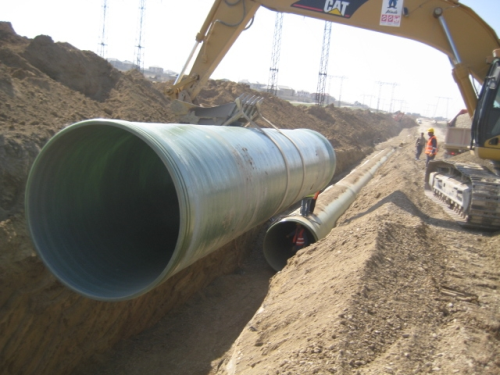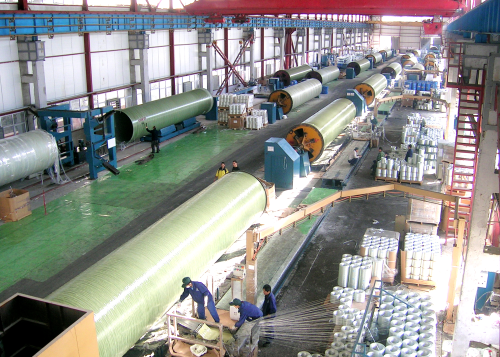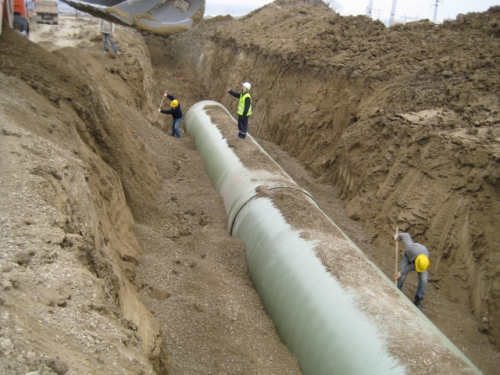


The year 2006 was a landmark year for large scale glass reinforced plastic (GRP) pipe production in Azerbaijan. Mr Rasul Bakhshaliyev founded Azkompozit, a new GRP pipe company, refurbished a Soviet era factory, purchased and installed filament winding machines and other equipment, and began the world's largest high pressure, large diameter GRP pipe project.
Azerbaijan became an independent nation in 1991, when the Soviet Union was dissolved, and is considered one of the most important spots in the world for oil exploration and production. This has led to rapid development of the country and its infrastructure.
The Oguz-Gabala-Baku Water Pipeline consists of 2 m diameter GRP pipe extending from fresh water wells in Oguz to the capital city of Baku, which is on the Caspian Sea. The pipeline will have a total length of 265 km. Since the water source is 410 m above sea level, the entire pipeline is gravity fed and has no pumps in the system. Unlike most pipelines, which require pumps, the Oguz-Gabala-Baku pipeline has to have pressure adjusting stations along the way. A head pressure of 410 m results in a pressure of 40 bar but the highest pressure in the system will be 25 bar. The pipeline crosses 12 rivers, eight motorways and two railways. The project is being done for Azersu, the Azerbaijan Water Ministry.
The pipe joints are being fabricated for 10 bar, 16 bar and 25 bar pressures. The pressure rating of the joints is dependent on the location within the system.
GRP was the material of choice
GRP was the material of choice for the Oguz-Gabala-Baku Water Pipeline for a number of important reasons. The high pressures eliminated materials such as concrete and polypropylene from consideration. Given the very high price of stainless steel, the short list of candidate materials included only GRP and coated carbon steel. GRP out performs coated steel in many ways.
One is the inherent corrosion resistance of GRP, inside, outside and through the thickness. In contrast to steel, GRP requires no special protection, such as cathodic protection, from corrosive soils. A scratch in steel pipe coating results in corrosion of the pipe, which will eventually lead to a breech and leakage. Since the pipeline is underground, leaks are difficult to detect and expensive to repair. In this service, GRP is immune from failures due to such minor imperfections.
Installation is a major challenge for a massive pipeline which passes through many types of terrains and crosses rivers, motorways and railways. The significantly lighter weight of GRP, as compared to steel, facilitates installation, reduces the size of the lifting equipment required and lowers the installation costs.
GRP has a higher Hazen-Williams roughness coefficient than new carbon steel pipe and much higher than corroded carbon steel pipe. This will result in higher water flow and, therefore, increased water delivery to the city of Baku.
Steep ramp up
Azkompozit was founded in January 2006 and started producing pipe in September of that year. This remarkable accomplishment was made possible by the teamwork of Azkompozit management headed by Rasul Bakhshaliyev, Michael Garnish of MG Composites Ltd, UK, and Mr Riyaz Khandwani of Metal House Dubai.
Mike Garnish has 36 years experience as GRP pipe engineer and started his career with Redland Co, the UK's first GRP pipe fabricator. MG Composites currently has pipe projects in the Middle East and in India. For this project, Garnish provided both manufacturing and pipe design consulting, providing the expertise needed in order to procure the wide range of necessary equipment. Riyaz Khandwani acted as the commercial adviser to Azkompozit and was responsible for logistics and procurement of the raw materials for the programme. Since Rasul Bakhshaliyev had not previously worked with composites, Khandwani's assistance was a vital contribution to the overall success of the project.
The Azkompozit factory is located in Sumgait, a suburb of Baku. The factory resulted from the extensive refurbishment of a Soviet era factory which had fallen into a bad state of repair. Within a few short months, an incredible 10 000 tons of debris were removed, the facility was cleaned up, repairs and new construction completed and fabrication equipment brought in, installed and brought on line. The factory compound has an area of 10.5 hectares (105 000 m2).
By the time the factory was complete, it was outfitted with 15 computerised winders and 50 each 2.0 m diameter mandrels. Complementing this are pipe pullers, overhead cranes, pressure testers, resin delivery systems and all sorts of other material handling equipment.Today, Azkompozit has 1500 employees, including management, accounting, QC and production staff.
Big numbers
The scale of the Oguz-Gabala-Baku Water Pipeline project is simply massive. Each joint of pipe is 12 m long and it will take 25 000 joints for the project. By the time it is complete, the project will take 18 to 24 months operating all 15 machines 24 hours per day, seven days per week.
The factory is producing on the order of 0.5 km of pipe per day.
The project will consume a total of 70 000 tons of glass fibre and 40 000 tons of resin. That is roughly the capacity of 5500 40 ft shipping containers!
The pipe has an isophthalic resin liner. Orthophthalic resin is being used for the structural portion. The winding glass is E-glass, which is industry standard. Most of the glass fibre is being purchased from China. The resin is being supplied by Scott Bader Middle East and Kemrock Industries.
Design, fabrication and testing
As previously mentioned, the pipe design was performed by Mike Garnish. He designed the pipe cylinders and the Bell & Spigot O-ring joints for pressures of 10, 16, 20 and 25 bar respectively. An O-ring joint is a relatively easy design for a 100 mm diameter pipe; a 2000 mm diameter pipe is a very different situation. The tolerance-to-diameter ratio is much smaller for a 2000 mm pipe as compared to a 100 mm. Careful attention must be given to the O-ring design and fabrication.
Since most of the pipe is buried, Garnish designed the pipe for the stiffness required by the burial depths and the soil moduli of the backfill materials. The most common design standard for buried pipe is American Water Works Association (AWWA) C-950.
GRP pipe joints can be either restrained or unrestrained. For above ground systems, it is impractical to use unrestrained joints since an unrestrained system requires continuous lateral support to keep the pipe joints in alignment. For buried piping either system can be used and there are inherent advantages and disadvantages to each system.
A restrained system does not require the use of thrust block to absorb the large axial forces. The size of thrust block for a large diameter, high pressure system can be surprisingly large. In cases where the soil has very low bearing capacity, thrust block design can be very difficult as the block might well sink under its own weight. Unrestrained pipe has essentially no axial stress, so the pipe is subjected to hoop stress not to bi-axial stress. This simplifies the laminate design and allows for a larger wind angle (relative to the axis of the pipe).
Restrained joint pipe is typically wound at 54° but the pipe for this project was wound at 63°. This results in greater hoop strength, greater hoop modulus (which increases pipe stiffness for a given thickness) and increased production rates. The relative carriage speed is reduced by about 40% for 63° pipe as compared to 54° pipe. Turn around problems are also reduced. In addition, the unrestrained joint pipe is not subject to axial strain growth which can become a large number over a lengthy run of pipe.
The factory has three pressure test machines and a parallel plate tester. Pressure test machines for unrestrained joint pipe must absorb the very large axial thrust forces. In the case of the 25 bar pipe, the axial test force is on the order of 1200 ton since the test pressure is 1.5 times design pressure. This requires a very large and heavy-duty testing machine. For the first few thousand meters of pipe, 100% pressure tests were performed. Only one joint had to be scrapped, which is remarkable. After a confidence level was established, testing was reduced to 1 out of every 10 joints.
The parallel plate machine was used for measured pipe stiffness, so these numbers could be compared with the values required by the calculations. Parallel plate tests are done using a ring cut from a piece of pipe. The force required to produce a given deflection is measured and stiffness calculated from this data. Start-up challenges
Azkompozit's achievements might lead to the conclusion it is relatively easy to start a large diameter GRP pipe company from scratch and take on such an enormous project. In fact, the start-up challenges were daunting.
Prior to this project, Rasul Bakhshaliyev had a steel pipe company. He brought his business experience and managerial talents to Azkompozit but was wise enough to know he needed expertise from a firm with decades of GRP experience. MG Composites provided not only the design and manufacturing expertise but also provided consulting for the sourcing of the materials. The latter was critical. FEMech Engineering of Harrison, Arkansas, USA, provided consultation in the early stages in regard to laminate quality issues. FEMech also provided Azkompozit with some resources to allow it to perform industry standard repairs. Once the production department went through the steep learning curve, the number of corrosion barrier defects dropped to a relatively low level.
Additional system
There is a further GRP pipe project associated with this trunk water main. In the mountains the water is drawn from aquifers which are replenished from snow melt and the water is gathered through a network of GRP pipes of total length about 43 km. The diameter of this gathering system is from 300 mm up to approximately 1500 mm.
Future plans
Azkompozit is undoubtedly the only company in the history of GRP to kick off business with such a massive project. The company is already making plans for future projects in the region and for more advanced winding. Plans are being made to acquire some 4-axis machines for winding of GRP pressure vessels and other complex products.
It is ‘ironic’ (pun intended) that the company is located on Metallurgist Street. It is even more ironic that less than three years ago Rasul Bakhshaliyev was in the steel pipe business. Azkompozit and the Oguz-Gabala-Baku Water Pipeline project have provided a very significant win over steel pipe.






